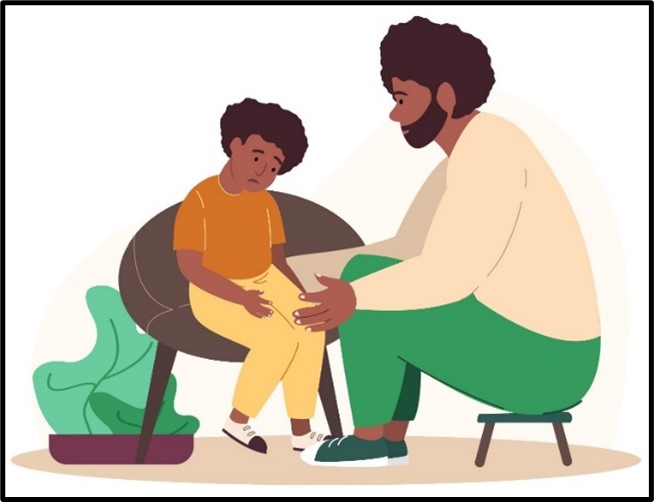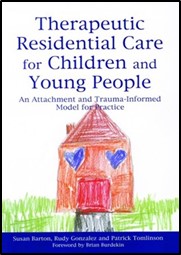PHYSICAL TOUCH IN THERAPEUTIC WORK WITH YOUNG PEOPLE WHO HAVE SUFFERED COMPLEX TRAUMA - PATRICK TOMLINSON (2024)
Date added: 22/02/24
Download a Free PDF of this Article

Abstract: This short article is about physical touch between adults and children in services that provide healing for children and young people who have suffered trauma and other adversities. It is relevant to those working with children and young people who are in out-of-home care, such as residential and foster care. It is also relevant to people working in other situations involving children, including schools and many other settings. The issue of touch has also become an anxiety for parents in ordinary family life. As Niall Kelly (2019) has said, touch has become a touchy subject. This article refers to the work of Barton et al. (2012) who wrote about physical contact in residential care, and the work of Martin Narey (2018) in his report on foster care in the UK. The issue of physical touch also brings into touch with other crucial issues such as affection and love. The article also refers to the groundbreaking work of the Scottish Journal of Residential Child Care (2016), which produced a special edition on ‘Love in Professional Practice’. Considering that this had previously been a taboo subject, it offered a much needed and hopeful perspective on the way we might make progress.
Introduction Physical touch is integral to the healthy relationship between a caregiver and a child. Touch has been shown to play a crucial part in bonding and affect regulation. The neuroscientist Bruce Perry (2021, p.266) emphasizes the importance of human touch to child development,
Touch is as essential for healthy physical and emotional development as calories and vitamins. If infants aren’t held or rocked – if they don’t experience the loving warmth of a caregiver’s touch – they won’t grow.
Many children in care have been deprived of appropriate physical contact and in many cases have experienced inappropriate touch through abuse. Safe touch plays an important part in building healthy relationships and the healing process. Clear policies need to be in place so that workers are sensitive to children’s histories and touch is used in an open way that is not unduly restricted. Perry (2021, p.269) explains how risk-averse practices that try to avoid touch can become unhelpful,
Here, have a toy. Be good and we will give you a thing. Giving toys instead of calming touch is an outrageously misguided practice, It’s the result of developmentally ignorant, trauma-uninformed policies – and another example of the need to change our systems.
However, it is important not to initiate physical contact until it is clear that it isn’t a trigger for the child that might have associations with physical or sexual abuse. Children who have been abused will often assume that any physical contact is a prelude to abuse. Children can be educated about safe touch and empowered to have control over physical contact. Having a sense of control and choice can also be important for children who have suffered trauma. Perry (2001, p.7) advises,
Be physical, caring and loving to children with attachment problems. Be aware that for many of these children, touch in the past has been associated with pain, torture or sexual abuse. In these cases, make sure you carefully monitor how they respond – be “attuned” to their responses to your nurturing and act accordingly. In many ways, you are providing replacement experiences that should have taken place during their infancy – but you are doing this when their brains are harder to modify and change. Therefore, they will need even more bonding experiences to help develop attachments.
Some children may be too physical and not know how to use appropriate touch. Sometimes they may touch others in a sexualized way: due to a lack of boundaries; the belief that sexual contact is normal between children, or adults and children; or as a way of testing how others will respond. Therefore, it is important to show and model appropriate touch, giving clear explanations where necessary.
Ironically, children with attachment problems will often initiate physical contact (hugs, holding hands, crawling into laps) with strangers. Adults misinterpret this as affectionate behaviour. It is not. It is best understood as "supplication" behaviour and it is socially inappropriate. How the adults handle this inappropriate physical contact is very important. (Perry 2001, p.7).
Children and young people can be helped to understand appropriate touch straightforwardly, without overcomplicating things or causing a child to feel bad or guilty. Furnivall et al. (2012, p.51) highlight how the issue of touch is relevant to the whole ethos of a healing environment,
Attachment is fundamentally about an intimate long-term connectedness between people that provides comfort, safety and opportunities for core emotional development. This intimacy cannot develop in a sterile or emotionally distant environment.
The aim is to strike the balance described – between the need for healthy and positive touch while recognizing how complex this can be and the need for a careful approach. Given the potential difficulties involved in this area, all staff must be appropriately trained to understand the relevant policy and practice guidelines. Confusion can lead to blurred boundaries, which can begin to reflect the children’s prior experiences.
The following section has been adapted from Barton et al. (2012).
 The Role of Touch in the Healing Process As we have been talking about the development of attachment relationships with children, we need to consider the role of touch in these relationships. This is especially so, as the children we work with have experienced major deprivation in their early years, where touch is such a central part of the attachment relationship. The issue of touch in relationships between adults and children has become particularly complex in recent years. We are all aware of the moral panic, which has had some impact on families and a huge one within settings that work with children. There has been a proliferation of guidelines produced by schools and all organizations that work with children. Advising professionals on appropriate behaviour and how to protect the safety of children and themselves from false allegations of abuse. Kelly (2019) highlights how institutionalizing and inhumane these fears can become when they become embedded in organizational policy,
The Role of Touch in the Healing Process As we have been talking about the development of attachment relationships with children, we need to consider the role of touch in these relationships. This is especially so, as the children we work with have experienced major deprivation in their early years, where touch is such a central part of the attachment relationship. The issue of touch in relationships between adults and children has become particularly complex in recent years. We are all aware of the moral panic, which has had some impact on families and a huge one within settings that work with children. There has been a proliferation of guidelines produced by schools and all organizations that work with children. Advising professionals on appropriate behaviour and how to protect the safety of children and themselves from false allegations of abuse. Kelly (2019) highlights how institutionalizing and inhumane these fears can become when they become embedded in organizational policy,
Organisations looking after children may feel that the best and safest practice is to avoid close contact with children altogether. Last month, Eilidh, a 15-year-old girl who was an in-patient in a Child and Adolescent Mental Health Service hospital was referred to our children’s home in Johnstone (Scotland). She was well enough to leave the hospital but not well enough to go home. Eilidh wrote to Seona Weir, who runs the service, to ask if she and her team gave hugs. She said that the nurses in the hospital were very nice, but they didn’t give hugs and she didn’t want to move to another place where this was also true. Eilidh had been a patient in hospital for six months and no staff member had hugged her.
Piper and Smith (2003, p.880) referred to numerous studies on this subject and highlighted the nature of confusion and anxiety that has developed,
The literature relating to ‘touch’ is extensive but most is concerned with promoting a particular viewpoint. For some, touch is good, for others it is a danger or therapeutic, but relatively few are concerned with the confusions and contradictions identified in this article.
Perry and Szalavitz (2006, p.140) advocated the positive benefits of touch in child development,
... touch is critical to human development. Sensory pathways involved in the experience of touch are the first to develop and are the most fully elaborated at birth compared to sight, smell, taste and hearing. Studies of premature babies find that gentle, skin-to-skin contact helps them gain weight, sleep better and mature more quickly. In fact, preemies who received such gentle massage went home from the hospital almost a week earlier on average. In older children and adults massage has also been found to lower blood pressure, fight depression and cut stress by reducing the amount of stress hormone released by the brain.
We work from an attachment perspective with children who have experienced long-term abuse and neglect. Our approach aims to redevelop the capacity for secure attachment in children. As part of this, the use of appropriate physical contact is encouraged. This is made additionally difficult as the children have often experienced not only a lack of healthy and nurturing touch, but also inappropriate touch involved in sexual and physical abuse. Therefore, we must be especially careful as children are likely to have previous memories triggered and react anxiously to touch. On the other hand, they may become overly sexualized, believing our intentions to be sexually motivated. Many children who have been abused believe that adults are only interested in them for sexual reasons. Sexualized and seductive behaviour may be typical for the child. This behaviour may have been used as a coping mechanism in situations where there were worse dangers for the child to contend with. Van der Kolk et al. (2007, p.321) argued,
In patients with histories of sexual abuse and other violations of personal boundaries, the meaning of touching needs to be clearly spelled out, understood and agreed to before it is introduced in the treatment. Interventions that involve touching need to be properly timed, after a secure relationship in which a patient can confidently register reactions has been established.
However, the answer to this is not to do as some organizations have done, which is to ban all physical contact. Not only does this potentially doubly deprive children but also reinforces the message that adults cannot be trusted. (Barton et al., 2012).
***
This anxiety about physical contact and excessively cautious approach continued. Blakemoore et al. (2022) refer to the Narey and Owers (2018) report on foster care in England, where Narey found that,
… in successive reviews for the Department of Education that both in children’s homes and foster homes, and all too often, staff and foster carers believed that demonstrations of physical affection were frowned upon, or they had been taught to be fearful of potential allegations. As Narey (2018) wrote,
“In one example, we heard of a foster carer in a room with other carers and changing a baby’s nappy. On completion, she raised the child’s Babygro and blew a raspberry on his bare tummy. Other foster carers in the room were very concerned that her expression of affection for the baby was inappropriate and could even be seen as a safeguarding issue. These concerns and anxieties can result in some children in care not receiving the physical or emotional affection they need that helps them to thrive. In turn, this will impact on the child’s ability to express their need for comfort, reassurance and understanding from an emotionally responsive carer. These are the fundamentals of a healthy childhood.”
There are many benefits of appropriate physical contact. Such as non-sexualized hugs, holding hands, and pats on the back. Appropriate touch helps create the capacity for attachment, which is partly learned through touch and proximity maintenance. Appropriate touch,
- Teaches appropriate forms of touch that are non-sexual and non-predatory. This is vital for children who haven’t experienced appropriate touch and who lack boundaries due to sexual abuse.
- Allows for dyadic emotional regulation, which assists in the development of emotional regulation skills in children with attachment difficulties.
- Provides a sense of ‘normal’ caring and family for the child. Some children, due to attachment-related trauma, may be operating at a pre-verbal stage of development. They may require physical approaches as part of their developmental process.
- Can assist in the relief of stress in children who have difficulties with emotional regulation.
- Can help promote positive body image, through the link between positive emotions and the body.
- Role models appropriate forms of affection.
Blakemoore et al. (2022, p.8) make the connection between physical touch, affection, and love,
Affection and physical touch are associated in ordinary family life with love. Steckley (2018, p. 368) highlights how love, which is fundamental in ordinary healthy families has been a taboo subject in residential care. There is now more attention to this, and love has been the subject of a special edition of the Scotland Journal of Residential Care (2016). The taboo on love is another institutionalising factor that has been imposed on residential care. (see also, Smith, 2016)
We understand that children who have experienced abuse may have difficulty and discomfort with physical contact. Any form of physical contact should be consensual, and the child should always be asked if they are comfortable with it. This is especially important at the beginning of the relationship where the child may be wary and likely to misinterpret things. It is important to gauge a child’s comfort by observing their reactions to touch. There is a balance to be struck between being thoughtful and respectful towards the child and not losing all spontaneity so that touch becomes an orchestrated clinical event! Physical contact with children is appropriate if it has a therapeutic purpose and is acceptable to both the carer and the child. Examples of appropriate physical contact include when it is part of comfort or emotional support; a hug to settle a child who is distressed, or as a greeting when meeting a child. It is vital in assessing the appropriateness of the physical contact the following be considered:
- The therapeutic benefit for the child
- The intent behind the physical contact between the carer and child
- The length of the relationship with the child
- The closeness of the relationship with the child
- The level of trust the child has towards the carer.
If touch is to feel natural and meaningful in a positive way to a child, we need to feel confident rather than anxious about our position. If the child perceives us to be acting anxiously around touch, this is likely to arouse their anxieties. Possibly suggesting that there is something wrong with physical contact between children and adults. Within an organizational setting, it will help workers to know exactly what the organization’s policy is. So that they can feel their practice is openly supported and not something worked out by individuals on their own.
References Barton, S., Gonzalez, R. and Tomlinson, P. (2012) Therapeutic Residential Care for Children and Young People: An Attachment and Trauma-informed Model for Practice, Jessica Kingsley Publishers
Blakemoore, E. Narey, M., Tomlinson, P. and Whitwell, J, (2022), What is Institutionalising for ‘Looked After’ Children and Young People?, in, Journal of Social Work Practice, Taylor and Francis, (2022 02 22)
Kelly, N. (2019) Kids in Care Homes Need a Hug Now and Then – But it’s a Touchy Subject, in, The Scotsman, Online Journal, 24th May 2019,
Narey, M. and Owers, M. (2018) Foster Care in England: A Review for the Department of Education, London
Perry, B.D. (2001) Bonding and Attachment in Maltreated Children: Consequences of Emotional Neglect in Childhood, The ChildTrauma Academy, www.ChildTraumaAcademy.org
Perry, B.D. and Szalavitz, M. (2006) The Boy Who Was Raised as a Dog: And Other Stories from a Child Psychiatrist’s Notebook, New York: Basic Books
Perry, B.D. and Winfrey, O. (2021) What Happened to You? Conversations on Trauma, Resilience, and Healing, New York: Flatiron Books
Piper, H. and Smith, H. (2003) ‘“Touch” in Educational and Child Care Settings: Dilemmas and Responses, in, British Educational Research Journal 29, 6, 879–894
Furnivall, J., McKenna, M., McFarlane, S. and Grant, E. (2012) Attachment Matters for All – An Attachment Mapping Exercise for Children's Services in Scotland, Centre for Excellence for Looked After Children in Scotland: Scottish Attachment in Action,
Smith, M. (Editor) (2016) Special issue: Love in Professional Practice, in, Scottish Journal of Residential Child Care, Vol 15 No 3, University of Strathclyde, Scotland: CELCIS (Centre for Excellence for Children's Care and Protection)
Steckley, L. (2018). Psychodynamic and Systems Theories Perspectives on Residential Child Care, in, Journal of Social Work Practice, 32(4), 365–372, https://doi.org/10.1080/02650533.2018.1503168
Van der Kolk, B.A., Van der Hart, O. and Marmar, C.R. (2007) Dissociation and Information Processing in Posttraumatic Stress Disorder, in, van der Kolk, B. A., McFarlane, A.C. and Weisaeth, L. (eds.) Traumatic Stress: The Effects of Overwhelming Experience on Mind, Body and Society, New York: Guilford Press
 Patrick Tomlinson Brief Bio The primary goal of Patrick’s work is the development of people and organizations. Throughout his career, he has identified development to be the driving force related to positive outcomes in personal, professional, and organizational life.
Patrick Tomlinson Brief Bio The primary goal of Patrick’s work is the development of people and organizations. Throughout his career, he has identified development to be the driving force related to positive outcomes in personal, professional, and organizational life.
Patrick’s experience spans from 1985 in the field of therapeutic services for young people who have suffered trauma and other adverse experiences. He has worked at all levels in organizations, up to Director and CEO. He is a consultant and mentor to professionals and organizations, focusing on development and leadership. He is the author/co-author/editor of numerous papers and books. He is a qualified clinician, strategic leader, and manager.
Website – www.patricktomlinson.com Contact – [email protected]
Files
Please leave a comment
Next Steps - If you have a question please use the button below. If you would like to find out more
or discuss a particular requirement with Patrick, please book a free exploratory meeting
Ask a question or
Book a free meeting













